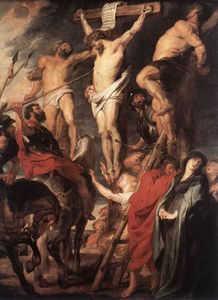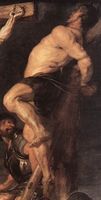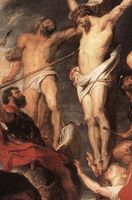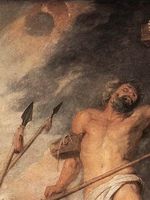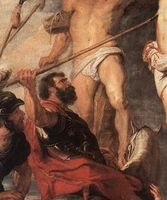Christ on the Cross Analysis
- Alternative Names:
- The Coup de Lance
- Height (cm):
- 429.00
- Length (cm):
- 311.00
- Medium:
- Oil
- Support:
- Other
- Subject:
- Scenery
- Art Movement:
- Baroque
- Created by:
- Current Location:
- Antwerp, Belgium
- Displayed at:
- Royal Museum of Fine Arts Antwerp
- Owner:
- Royal Museum of Fine Arts Antwerp
- Christ on the Cross Analysis Page's Content
- Composition
- Use of color
- Use of Technique
Christ on the Cross Composition
Rubens creates an uncommon compositional technique for this piece. The conventional placing always had the three crosses in which Christ was usually situated either to the front and middle which made him the core focus. In this work, the crosses are on a slant running from right to left and are twisted at different angles.
The color composition is such that the top half of this canvas is in black and the bottom is lighter and he paints the subjects as the third layer which adds dimension and depth and accentuates the subject matter.
The figures are displayed on various planes from right to left. Subjects such as St John at the foot of the cross and the thief on the right with a contorted posture all serve to direct our gaze to Christ as the central focus. Longinus' lance also directs our gaze, as well as the lances in the background.
Rubens also created a type of pyramid in this work which resembles many of his other religious paintings, highlighting the presence of the main religious figure.
Christ on the Cross Use of color
In Christ on the Cross Rubens captures the light with his mastery of colors. Depicted in overwhelming semi-darkness below stormy nimbus clouds, Rubens still defines stark and bright color in the fabrics. He uses tremendous tones of reds, deep browns and highlighted flesh tones to accentuate his figures.
The flesh tones work to highlight the drama of the human bodies in the painting making the action visible and also defining skin texture, muscle contortions and posture. Notably, the flesh hues use to portray Christ are much lighter than his fellow hangers. His skin is clear and smooth and a white sheen is used to accentuate his presence.
Rubens uses bright and startling gold ochres for the pleading Mary Magdalene and her hair and gown are golden, helping to create a focus point amidst the agony of this image.
The artist uses blacks and an array of grays for the stormy sky following the crucifixion, making it highly symbolic. Black dominates the whole top half of the image so that the right side is completely enveloped in darkness.
Dark greens with black hues are used for the Italian-inspired landscape background which can be seen behind the cross.
Christ on the Cross Use of Technique
Rubens still managed to define stark lighting with his own color schemes in this work despite the fact that half of the canvas is swathed in darkness. The dark top half of the canvas is contrasted with a light bottom half.
Light emits from the top left hand side and the clouds slightly part to show a brown/gray hue of a sky as waning light falls on the subjects.
The various folds in the clothing also help define the light source and Rubens uses various shades for this. His deep browns on the horse to the left bottom hand side help create perspective and depth.
Light and shadows are deeply pronounced on Longinus' arm which holds the spear. The viewer is aware of the light source streaming in from the left as all objects and subjects facing Christ are in the shade. This is also accentuated by the shadows of the horses.
Cleverly, those standing before Christ have their faces in shadow, while His devotees who stand behind him or alongside the cross face the light, thus symbolically emphasizing their devotion. This technique also accentuates Christ as the central figure and their upward gazes and bodily gestures within the light direct the eye to Jesus.

